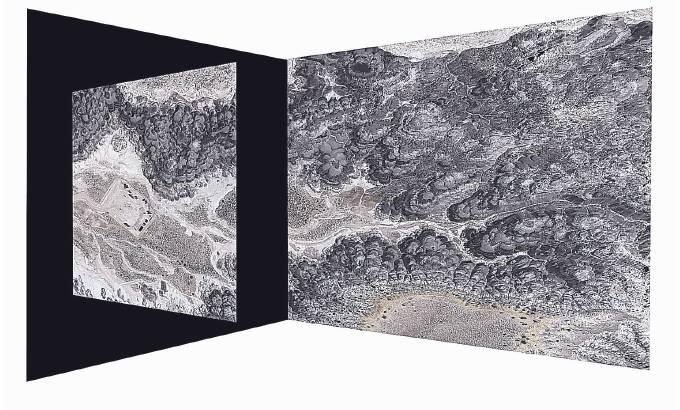
Michael Namingha heard about the Black Place during a slide lecture at New York’s Parsons School of Design.
Georgia O’Keeffe referred to the softly rounded gray formations on either side of N. M. 550 as a ” mile of elephants.” The artist traveled to the dramatic landscape in the 1930 s, making many arduous road trips there from her Abiquiú home, setting up camp with her friend Maria Chabot and the photographer Eliot Porter. O’Keeffe produced more than a dozen drawings, pastels and some of her best-known oil paintings, including ” Black Place II,” now hanging in New York’s Metropolitan Museum of Art.
Namingha traveled to the Black Place in 2017 to discover a very different landscape in his photographically-based work. The results will hang in the Georgia O’Keeffe Museum through Oct. 28.
Namingha journeyed to the Black Place carrying a single tool – a drone camera. He returned to his Santa Fe studio with digital photographs and video recordings he developed into individual works defined by a contemporary spare aesthetic.
On federal land about a mile from the turnoff to Chaco Canyon, the Black Place is surrounded by evidence of the world’s energy needs: oil rigs, pipelines, storage pads; the detritus of fracking.
Former O’Keeffe Museum curator Carolyn Kastner asked Namingha to create a body of work in response to O’Keeffe’s. He began by examining the site using Google Earth.
” As I was zooming in and out, I saw what looked like parking lots were actually drilling pads,” he said. He drove out to the site with Kastner in April.
” The landscape was very fragile,” he said.” The drone allowed me to get up close and personal ” without damaging the landscape.
Back home, he divided, shifted and pulled the images using commands such as ” skew ” and ” distort.”
” O’Keeffe uses the same kind of language around abstraction,” Kastner said.” He uses the computer and the camera in the same way.”
Once Namingha created the shape, he added geometric bands of color to emphasize, highlight and complicate the visual meaning.
” I used the colors to represent what is happening with drilling and fracking and natural gas extraction,” he said.
The hot pink reflects NASA maps from satellite data recording a large concentration of methane over the Four Corners region. Yellow represents the poles placed in the ground to signal the pipeline.
” What also struck me was this highway that runs through the Black Place,” Namingha said.” When ( O’Keeffe ) was out there, there was no highway.”
Namingha says he harbors no political motivations for creating the works.
” I just want people to be aware of what’s happening in this area, because it’s not just here; it’s everywhere.”
IF YOU GO
WHAT: ” The Black Place: Georgia O’Keeffe and Michael Namingha ”
WHEN: Through Oct. 28; talk with the artist and art critic and curator Lucy Lippard at Eldorado Hotel, 309 W. San Francisco St., Santa Fe, at 5: 30 p. m. Thursday, May 17.
WHERE: Georgia O’Keeffe Museum, 217 Johnson St., Santa Fe
HOW MUCH: $13 general; $11 students 18 + with ID, children under 18 free, members free. Info, okeeffemuseum. org or 505-946-1000

Leave A Comment